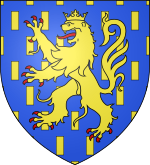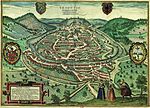Musée des Beaux-Arts et d'Archéologie de Besançon

The musée des Beaux-Arts et d'Archéologie (Museum of Fine Arts and Archeology) in the French city of Besançon is the oldest public museum in France. It was set up in 1694, nearly a century before the Louvre became a public museum. Reorganized from 1967 to 1970 by Louis Miquel, a pupil of Le Corbusier, the museum is again the subject of a total renovation and an enlargement from October 2015. Three years later, the completely renovated museum was inaugurated on November 16, 2018 in the presence of the President of the Republic Emmanuel Macron, the Minister of Culture Franck Riester and the Mayor Jean-Louis Fousseret. Attendance is then on the rise with 105,459 visitors recorded at the end of 2019.
Excerpt from the Wikipedia article Musée des Beaux-Arts et d'Archéologie de Besançon (License: CC BY-SA 3.0, Authors, Images).Musée des Beaux-Arts et d'Archéologie de Besançon
Rue Claude Goudimel, Besançon République
Geographical coordinates (GPS) Address Phone number Website External links Nearby Places Show on map
Geographical coordinates (GPS)
| Latitude | Longitude |
|---|---|
| N 47.2402 ° | E 6.0231 ° |
Address
Musée des Beaux-Arts et d'Archéologie
Rue Claude Goudimel 6
25000 Besançon, République
Bourgogne-Franche-Comté, France
Open on Google Maps









